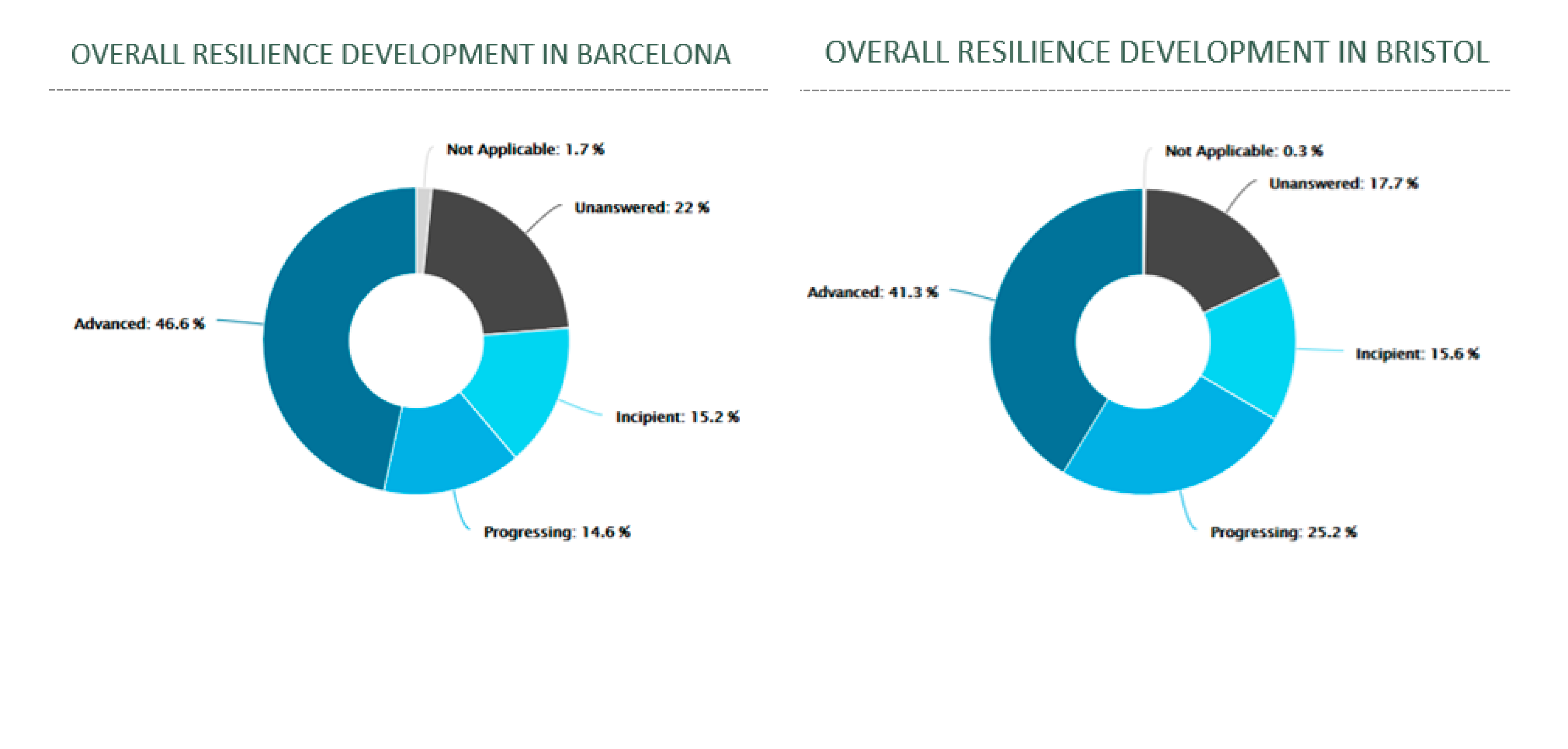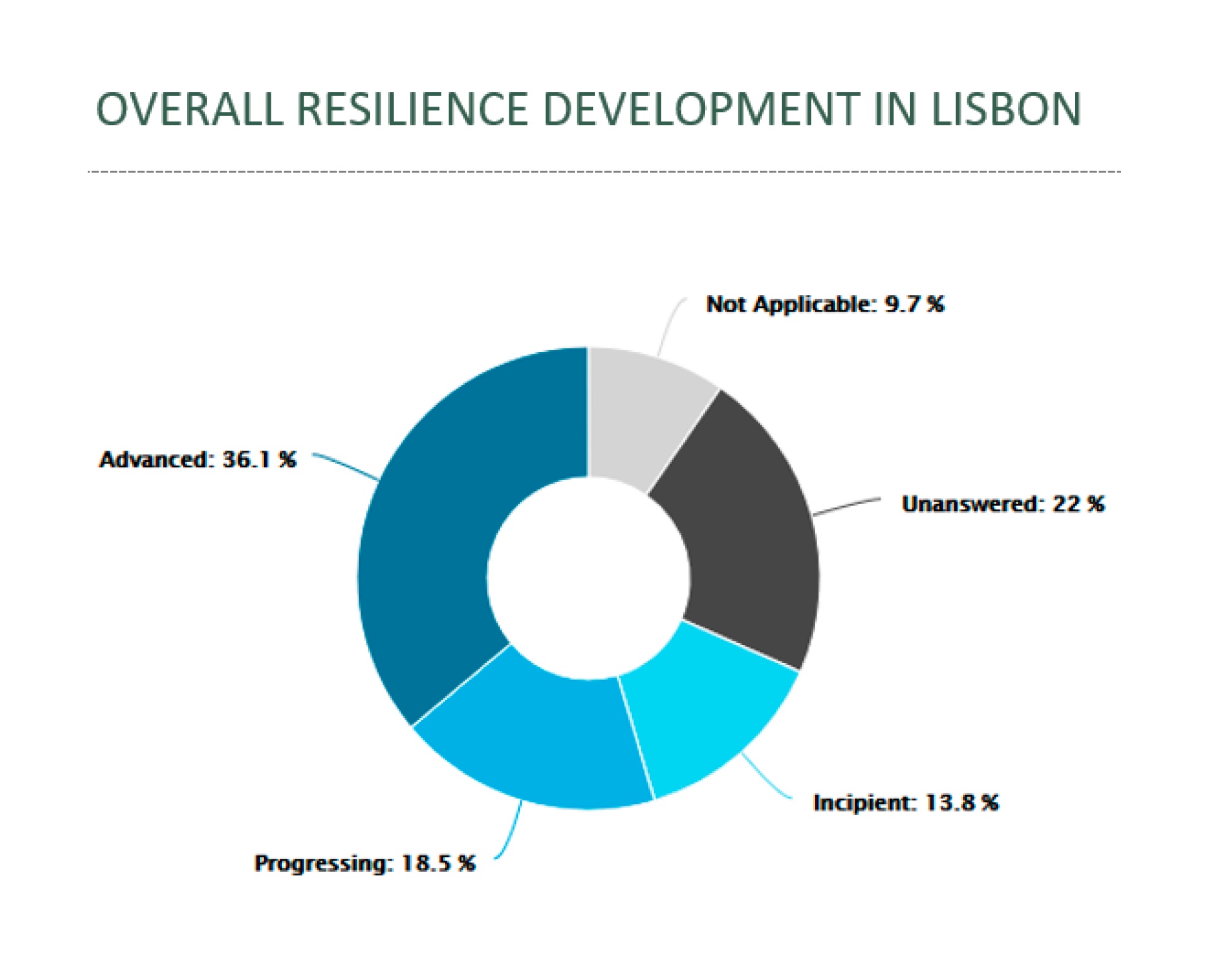Following a Step by Step Development of a Resilience Action Plan
Abstract
1. Introduction
2. Methodology
2.1. Planning Process
2.2. Risk Assessment
2.3. Resilience Assessment
2.4. SWOT Analysis
2.5. Strategies Development and Implementation, Monitoring and Review Processes
2.5.1. Identification of Strategies
- -
- Typology: considering groups of strategies of the same type, such as “Citizens and stakeholders or infrastructural construction and rehabilitation”;
- -
- TOWS perspective: the combination addressed in the SWOT that supported the strategy definition, e.g., WT strategy, combines identified Weaknesses and Threats;
- -
- Implementation: describing whether the strategy is in progress or is still planned for the future;
- -
- Timeline: the horizon or period for implementation;
- -
- Hazards and climate variables: variables that are addressed in the strategy;
- -
- Institution, players and services: all stakeholders involved in the implementation;
- -
- Cost: the financial effort needed or cost range for the strategy;
- -
- Measures: the set of resilience measures needed to implement the strategy;
- -
- Co-benefits: benefits of the strategy that are not directly obtained, regarding diverse aspects within economic, social, and environmental categories. They may have a relevant or slight contribution to these aspects and can be immediate or require additional time for them to be evident. Economic co-benefits include aspects such cost savings, job creation, and property values; social co-benefits include, among others, reduced mortality or health impacts and reduced mortality from diseases; and environmental co-benefits include improved air or water quality, reduced aquifer depletion and water pollution or land contamination;
2.5.2. Implementation, Monitoring, and Review Processes
3. Results of Barcelona, Bristol, and Lisbon Resilience Action Planning
3.1. Background
3.2. Climate Change and Planning Scenarios
3.3. Risk Assessment
3.3.1. Overall of the Three Cities
3.3.2. Lisbon Hazard Assessment
3.4. Resilience Assessment
3.5. SWOT Analysis
3.6. Strategies Development
3.6.1. Identification of Strategies
3.6.2. Impact Assessment of Identified Strategies
3.6.3. Strategies Prioritization, Implementation Plan, and Monitoring and Review
4. Discussion
5. Conclusions
Supplementary Materials
Author Contributions
Funding
Acknowledgments
Conflicts of Interest
References
- Yigitcanlar, T.; Teriman, S. Rethinking sustainable urban development: Towards an integrated planning and development process. Int. J. Environ. Sci. Technol. 2015, 12, 341–352. [Google Scholar] [CrossRef]
- UN. Global Sustainable Development Report 2019: The Future Is Now—Science for Achieving Sustainable Development. Report of United Nations Independent Group of Scientists Appointed by the Secretary-General. 2019. Available online: https://sustainabledevelopment.un.org/content/documents/24797GSDR_report_2019.pdf (accessed on 21 August 2020).
- Labaka, L.; Maraña, P.; Giménez, R.; Hernantes, J. Defining the roadmap towards city resilience. Technol. Forecast. Soc. Chang. 2019, 146, 281–296. [Google Scholar] [CrossRef]
- Sharifi, A. Resilient urban forms: A macro-scale analysis. Cities 2019, 85, 1–14. [Google Scholar] [CrossRef]
- Meerow, S.; Newell, J.P.; Stults, M. Defining urban resilience: A review. Landsc. Urban Plan. 2016, 147, 38–49. [Google Scholar] [CrossRef]
- Desouza, K.C.; Flanery, T.H. Designing, planning, and managing resilient cities: A conceptual framework. Cities 2013, 35, 89–99. [Google Scholar] [CrossRef]
- Vallejo, L.; Mullan, M. Climate-Resilient Infrastructure: Getting the Policies Right; OECD Environment Working Papers, No. 121; OECD Publishing: Paris, France, 2017. [Google Scholar] [CrossRef]
- ICLEI. Preparing for Climate Change: A Guidebook for Local, Regional, and State Governments; ICLEI—Local Governments for Sustainability: Bonn, Germany, 2007; Available online: https://icleiusa.org/wp-content/uploads/2015/08/PreparingForClimateChange_Sept2007.pdf (accessed on 21 August 2020).
- Saavedra, C.; Budd, W.W. Climate change and environmental planning: Working to build community resilience and adaptive capacity in Washington State, USA. Habitat Int. 2009, 33, 246–252. [Google Scholar] [CrossRef]
- Weihrich, H. The TOWS matrix—A tool for situational analysis. Long Range Plan. 1982, 15, 54–66. [Google Scholar] [CrossRef]
- Santamouris, M.; Cartalis, C.; Synnefa, A. Local urban warming, possible impacts and a resilience plan to climate change for the historical center of Athens, Greece. Sustain. Cities Soc. 2015, 19, 281–291. [Google Scholar] [CrossRef]
- UNHabitat. Planning for Climate Change: A Strategic, Values-Based Approach for Urban Planners; Cities and Climate Change Initiative Tool Series; United Nations Human Settlements Programme: Nairobi, Kenya, 2014; Available online: https://unhabitat.org/sites/default/files/download-manager-files/Planning%20for%20Climate%20Change.pdf (accessed on 19 October 2020).
- UNHabitat. Guiding Principles for City Climate Action Planning; United Nations Human Settlements Programme: Nairobi, Kenya, 2015; Available online: https://e-lib.iclei.org/wp-content/uploads/2016/02/Guiding-Principles-for-City-Climate-Action-Planning.pdf (accessed on 19 October 2020).
- Buijs, J.-M.; Boelens, L.; Bormann, H.; Restemeyer, B.; Terpstra, T.; Van Der Voorn, T. Adaptive planning for flood resilient areas: Dealing with complexity in decision-making about multilayered flood risk management. In Proceedings of the 16th Meeting: Adaptive Planning for Spatial Transformation, Groningen, The Netherlands, 23–25 May 2018; p. 23. Available online: https://www.projectenportfolio.nl/images/archive/e/ea/20180906092418%2120180430_Paper_Aesop_FRAMES.pdf (accessed on 19 October 2020).
- Van der Voorn, T.; Quist, J.; Pahl-Wostl, C.; Haasnoot, M. Envisioning robust climate change adaptation futures for coastal regions: A comparative evaluation of cases in three Continents. Mitig. Adapt. Strateg. Glob. Chang. 2017, 22, 519–546. [Google Scholar] [CrossRef]
- NIST. Community Resilience Planning Guide for Buildings and Infrastructure Systems; NIST Special Publication 1190; National Institute of Standards and Technology: Gaithersburg, MD, USA, 2016; Volume I. [CrossRef]
- Cardoso, M.A.; Brito, R.S.; Pereira, C.; Gabàs, A.; González Gómez, A.; Goodey, P.; Lopes, R.; Martínez, M.; Russo, B.; Telhado, M.J.; et al. Resilience Action Plans of the RESCCUE Cities; D6.2 RESCCUE Project (Public); RESCCUE Project: Barcelona, Spain, 2020. [Google Scholar]
- Monjo, R.; Paradinas, C.; Gaitán, E.; Redolat, D.; Prado, C.; Pórtoles, J.; Torres, L.; Russo, B.; Velasco, M.; Ribalaygua, J. Final Climate Scenarios Report; D1.2 RESCCUE Project (Public); RESCCUE Project: Barcelona, Spain, 2017. [Google Scholar]
- Monjo, R.; Paradinas, C.; Gaitán, E.; Redolat, D.; Prado, C.; Pórtoles, J.; Torres, L.; Russo, B.; Velasco, M.; Pouget, L.; et al. Report on Extreme Events Prediction; D1.3 RESCCUE Project (Public); RESCCUE Project: Barcelona, Spain, 2018. [Google Scholar]
- Canalias, M.; Fontanals, I.; Soler, P.; Vendrell, E. Report from HAZUR® Implementation in Each City; D4.1 RESCCUE Project (Confidential); RESCCUE Project: Barcelona, Spain, 2017. [Google Scholar]
- UNIDSR. Disaster Resilience Scorecard for Cities. Preliminary Level Assessment; United Nations Office for Disaster Reduction: Geneva, Switzerland, 2015. [Google Scholar]
- McClinton, P. Strategic Management Analysis Tools: A Review of the Literature. Liberty University, Virginia, EUA. Academia.edu. 2015. Available online: http://www.academia.edu/7055342/Strategic_Management_Analysis_Tools (accessed on 21 August 2020).
- Russo, B.; Sunyer, D.; Locatelli, L.; Yubero, D.; Vela, S.; Martínez, E.; Martínez, G.; Palau, A.; De Prada, M.; Dominguéz, G.; et al. Multi-Hazards Assessment Related to Water Cycle Extreme Events for Current Scenario (Public Summary); D2.4 RESCCUE Project (Public); RESCCUE Project: Barcelona, Spain, 2018. [Google Scholar]
- Cardoso, M.A.; Brito, R.S.; Pereira, C.; Gonzalez, A.; Stevens, J.; Telhado, M.J. RAF Resilience Assessment Framework—A Tool to Support Cities’ Action Planning. Sustainability 2020, 12, 2349. [Google Scholar] [CrossRef]
- Cardoso, M.A.; Brito, R.S.; Almeida, M.C. Approach to develop a climate change resilience assessment framework. H2Open J. 2020, 3, 77–88. [Google Scholar] [CrossRef]
- Martínez-Gomariz, E.; Vela, S.; García, L.; Mendoza, E.; Martínez, M.; Stevens, J.; Almeida, M.C.; Telhado, M.J.; Morais, M.; Silva, I.C.; et al. Multisectorial Resilience Strategies Framework and Strategies Database Development; D5.1 RESCCUE Project (Public); RESCCUE Project: Barcelona, Spain, 2017. [Google Scholar]
- Martínez-Gomariz, E.; Guerrero, M.; Martínez, M.; Stevens, J.; Almeida, M.C.; Pereira, C.; Morais, M.; Telhado, M.J.; Silva, I.C.; Duarte, N.; et al. Report on Methodologies for the Selection of Resilience Strategies; D5.2 RESCCUE Project (Public); RESCCUE Project: Barcelona, Spain, 2019. [Google Scholar]
- Guerrero-Hidalga, M.; Martínez-Gomariz, E.; Evans, B.; Webber, J.; Termes-Rifé, M.; Russo, B.; Locatelli, L. Methodology to Prioritize Climate Adaptation Measures in Urban Areas. Barcelona and Bristol Case Studies. Sustainability 2020, 12, 4807. [Google Scholar] [CrossRef]
- Pagani, G.; Fournière, H.; Cardoso, M.A.; Brito, R.S. Report with the Resilience Diagnosis for Each City; RESCCUE Project (Confidential); RESCCUE Project: Barcelona, Spain, 2018. [Google Scholar]
- UNISDR and CML (Lisbon’s Civil Protection Service). Lisbon’s Resilience Action Plan. 2017. Available online: https://www.preventionweb.net/english/professional/policies/v.php?id=56369 (accessed on 2 October 2020).
- González, A.; Gabàs, A.; Cardoso, M.A.; Brito, R.S.; Pereira, C.; Russo, B.; Martínez, M.; Velasco, M.; Domínguez, J.L.; Sánchez-Muñoz, D.; et al. Barcelona Resilience Action Plan. In Resilience Action Plans of the RESCCUE Cities; D6.2 RESCCUE Project (Public); RESCCUE Project: Barcelona, Spain, 2020. [Google Scholar]
- Stevens, J.; Goodey, P.; Cardoso, M.A.; Brito, R.S.; Pereira, C.; Henderson, R.; Colclough, G.; Evans, B.; Chen, A.; Gibson, M.; et al. Bristol Resilience Action Plan. In Resilience Action Plans of the RESCCUE Cities; D6.2 RESCCUE Project (Public); RESCCUE Project: Barcelona, Spain, 2020. [Google Scholar]
- Telhado, M.J.; Morais, M.; Cardoso, M.A.; Brito, R.S.; Pereira, C.; Lopes, R.; Barreiro, J.; Pimentel, N.; Silva, I.C.; Duarte, N.; et al. Lisbon Resilience Action Plan. In Resilience Action Plans of the RESCCUE Cities; D6.2 RESCCUE Project (Public); RESCCUE Project: Barcelona, Spain, 2020. [Google Scholar]
- Martínez-Gomariz, E.; Russo, B.; Gómez, M.; Plumed, A. An approach to the modelling of stability of waste containers during urban flooding. J. Flood Risk Manag. 2019, 13 (Suppl. 1), e12558. [Google Scholar] [CrossRef]
- Sánchez-Muñoz, D.; Domínguez-García, J.L.; Martínez-Gomariz, E.; Russo, B.; Stevens, J.; Pardo, M. Electrical Grid Risk Assessment Against Flooding in Barcelona and Bristol Cities. Sustainability 2020, 12, 1527. [Google Scholar] [CrossRef]
- Almeida, M.C.; Telhado, M.J.; Morais, M.; Barreiro, J.; Lopes, R. Urban Resilience to Flooding: Triangulation of Methods for Hazard Identification in Urban Areas. Sustainability 2020, 12, 2227. [Google Scholar] [CrossRef]
- Evans, B.; Chen, A.S.; Djordjević, S.; Webber, J.; Gómez, A.G.; Stevens, J. Investigating the Effects of Pluvial Flooding and Climate Change on Traffic Flows in Barcelona and Bristol. Sustainability 2020, 12, 2330. [Google Scholar] [CrossRef]
- Stevens, J.; Henderson, R.; Webber, J.; Evans, B.; Chen, A.; Djordjević, S.; Sánchez-Muñoz, D.; Domínguez-García, J. Interlinking Bristol Based Models to Build Resilience to Climate Change. Sustainability 2020, 12, 3233. [Google Scholar] [CrossRef]
- Locatelli, L.; Guerrero, M.; Russo, B.; Martínez-Gomariz, E.; Sunyer, D.; Martínez, M. Socio-Economic Assessment of Green Infrastructure for Climate Change Adaptation in the Context of Urban Drainage Planning. Sustainability 2020, 12, 3792. [Google Scholar] [CrossRef]
- Forero-Ortiz, E.; Martínez-Gomariz, E.; Cañas Porcuna, M.; Locatelli, L.; Russo, B. Flood Risk Assessment in an Underground Railway System under the Impact of Climate Change—A Case Study of the Barcelona Metro. Sustainability 2020, 12, 5291. [Google Scholar] [CrossRef]
- Russo, B.; Velasco, M.; Locatelli, L.; Sunyer, D.; Yubero, D.; Monjo, R.; Martínez-Gomariz, E.; Forero-Ortiz, E.; Sánchez-Muñoz, D.; Evans, B.; et al. Assessment of Urban Flood Resilience in Barcelona for Current and Future Scenarios. The RESCCUE Project. Sustainability 2020, 12, 5638. [Google Scholar] [CrossRef]
- Huber, W. StormWater Management Model (SWMM) Bibliography; Environmental Research Laboratory, Office of Research and Development: Athens, GA, USA; U.S. Environmental Protection Agency: Washington, DC, USA, 1985.
- VAW. BASEMENT—Basic Simulation Environment for Computation of Environmental Flow and Natural Hazard Simulation. Version 2.8; ETH Zurich: Zurich, Switzerland, 2018. [Google Scholar]
- Russo, B.; Sunyer, D.; Locatelli, L.; Martínez, E.; Almeida, M.C.; David, L.M.; Telhado, M.; Morais, M.; Duarte, N.; Lopes, R.; et al. Multi-Hazards Assessment Related to Water Cycle Extreme Events for Future Scenarios (Business as Usual); D2.3 RESCCUE Project (Confidential); RESCCUE Project: Barcelona, Spain, 2019. [Google Scholar]
- Evans, B.; Djordjevic, S.; Chen, A.S.; Velasco, M.; Russo, B.; Martinez, E.; Daura, E.; Vela, S.; Palau, A.; Dominguez, J.L.; et al. Development of Methodology for Modelling of Cascading Effects and Translating Them into Sectorial Hazards; D3.3 RESCCUE Project (Public); RESCCUE Project: Barcelona, Spain, 2018. [Google Scholar]
- Evans, B.; Djordjevic, S.; Chen, A.S.; Gibson, M.; Almeida, M.C.; Telhado, M.; Morais, M.; Silva, I.C.; Duarte, N.; Martínez, E.; et al. Impact Assessments of Multiple Hazards in Case Study Areas; D3.4 RESCCUE Project (Confidential); RESCCUE Project: Barcelona, Spain, 2019. [Google Scholar]
- Cardoso, M.A.; Brito, R.S.; Pereira, C.; David, L.; Almeida, M.C. Resilience Assessment Framework RAF—Description and Implementation; D6.4 RESCCUE Project (Public); RESCCUE Project: Barcelona, Spain, 2020. [Google Scholar]
- Cardoso, M.A.; Brito, R.S.; Pereira, C. Resilience Assessment Framework Tool—RAF APP; D6.5 RESCCUE Project (Public); RESCCUE Project: Barcelona, Spain, 2020. [Google Scholar]
- Evans, B.; Djordjevic, S.; Chen, A.S.; Webber, J.; Russo, B.; Forero Ortiz, E.; Martinez, E.; Guerrero Hidalga, M.; Dominguez, J.L.; Almeida, M.C.; et al. Impact Assessments of Multiple Hazards in Case Study Areas (with Adaptation Strategies); D3.6 RESCCUE Project (Confidential); RESCCUE Project: Barcelona, Spain, 2020. [Google Scholar]
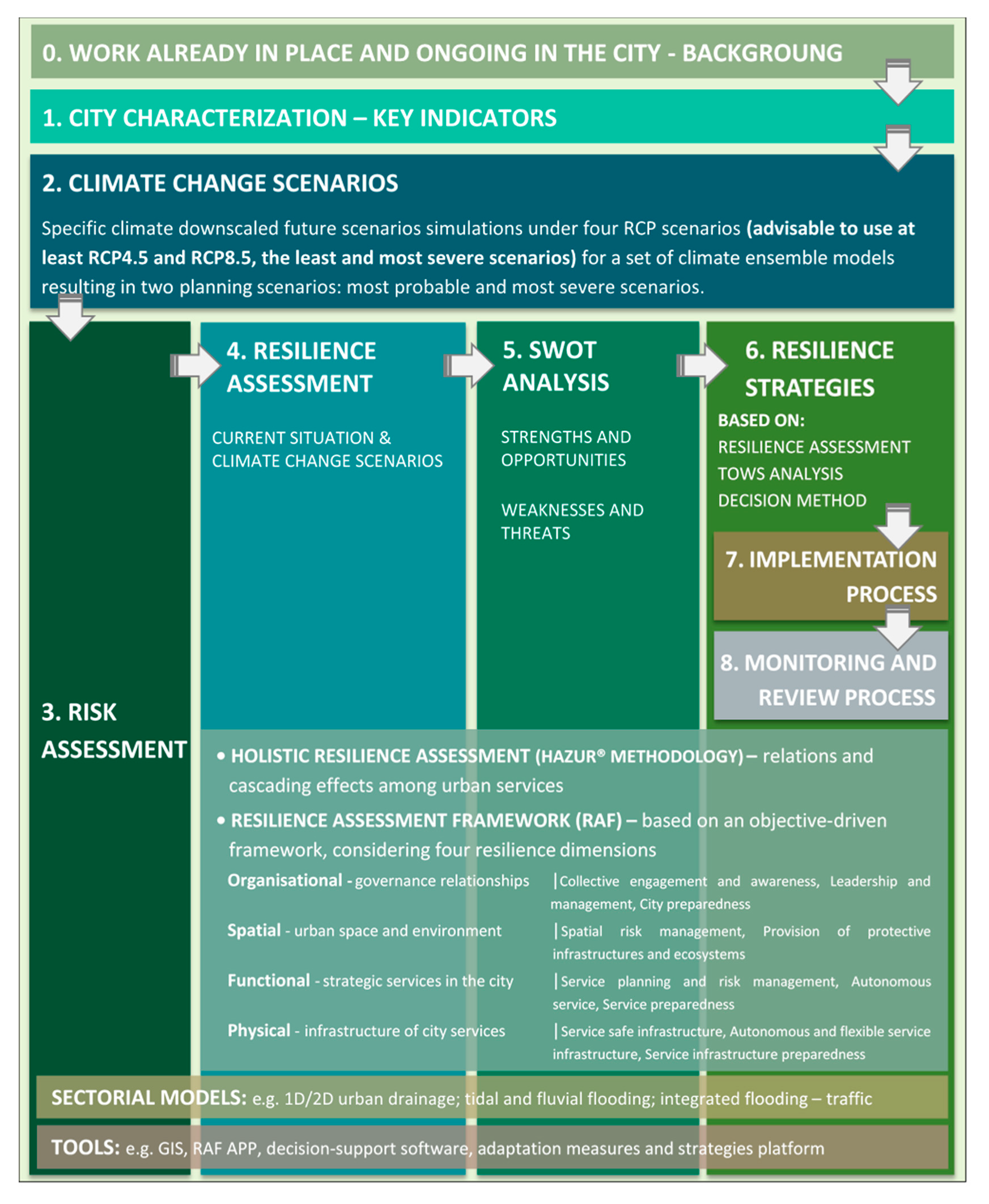
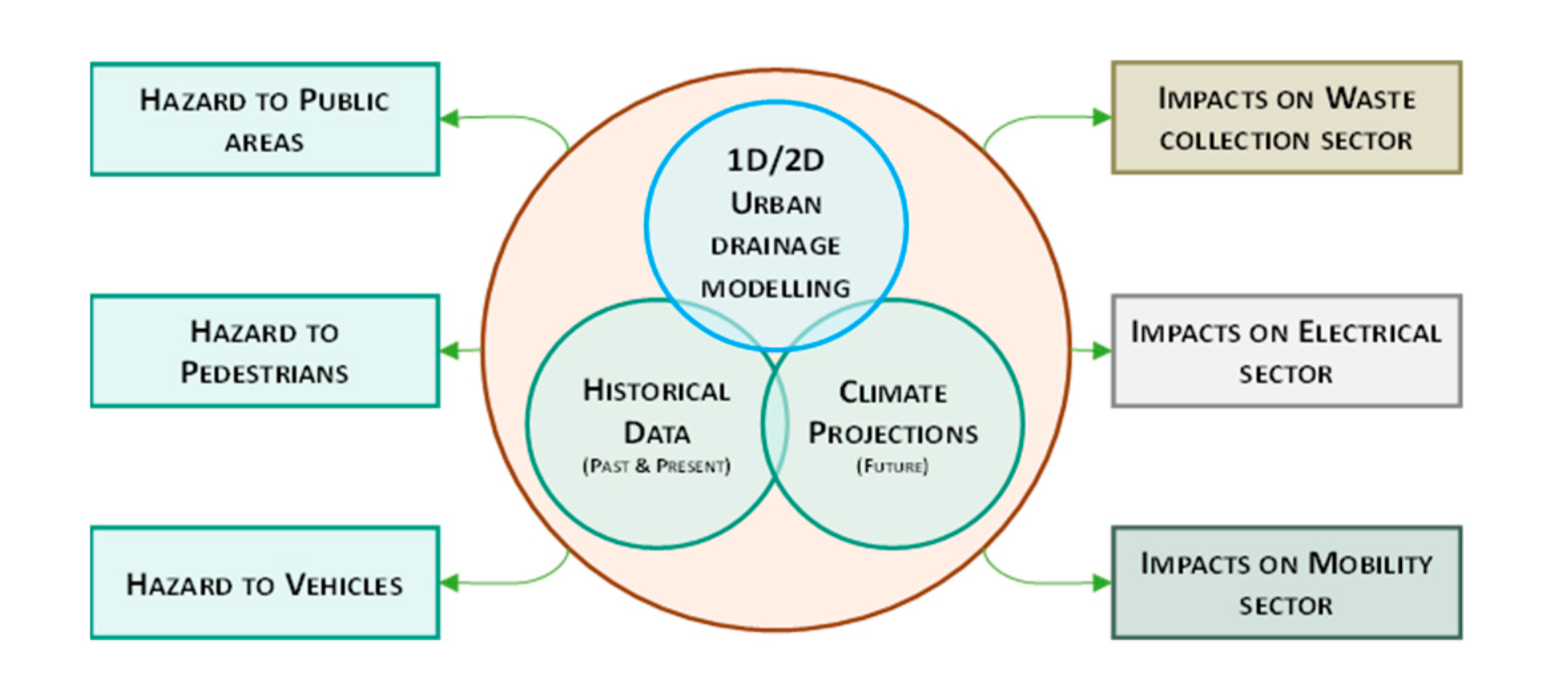
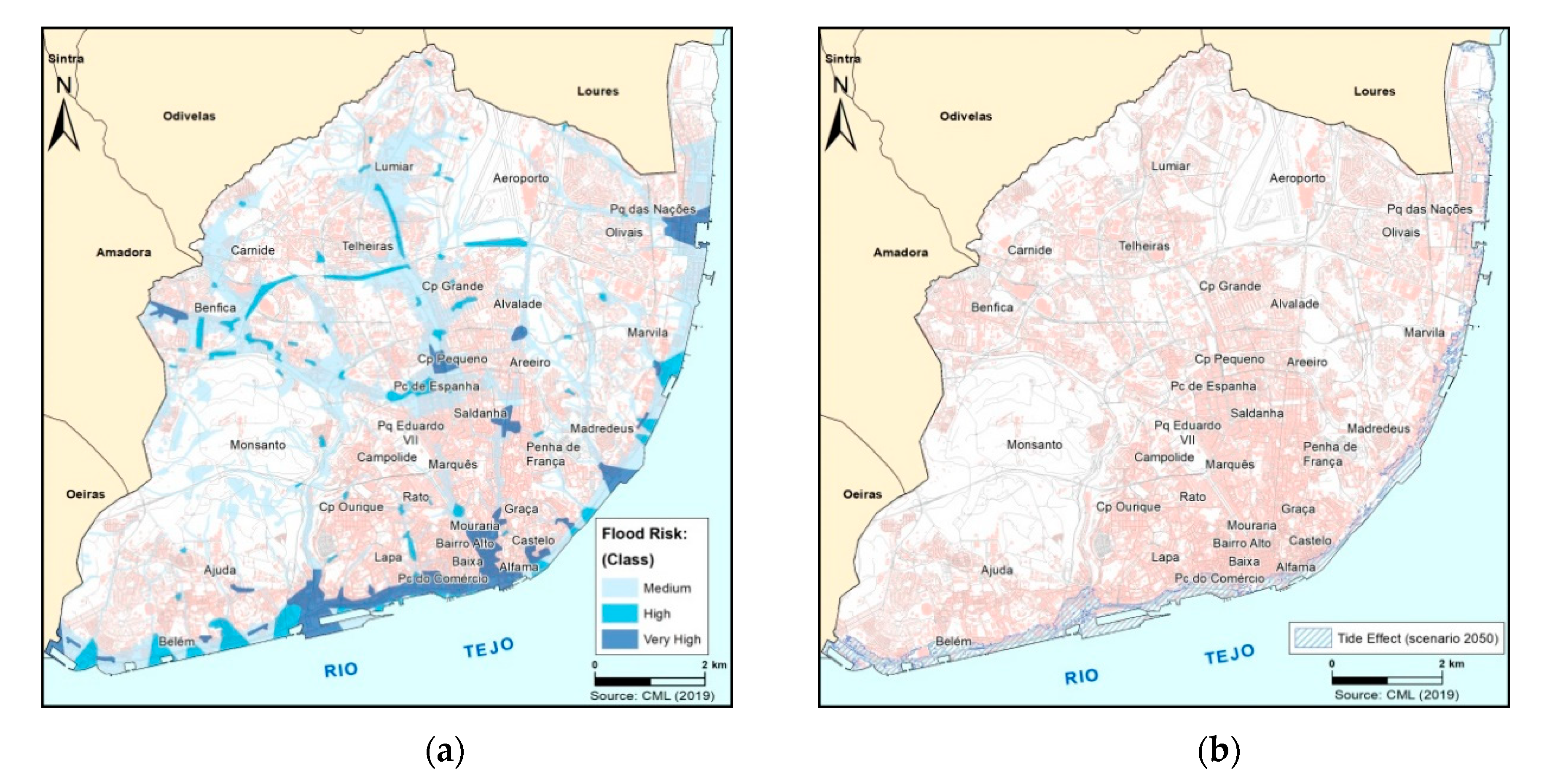
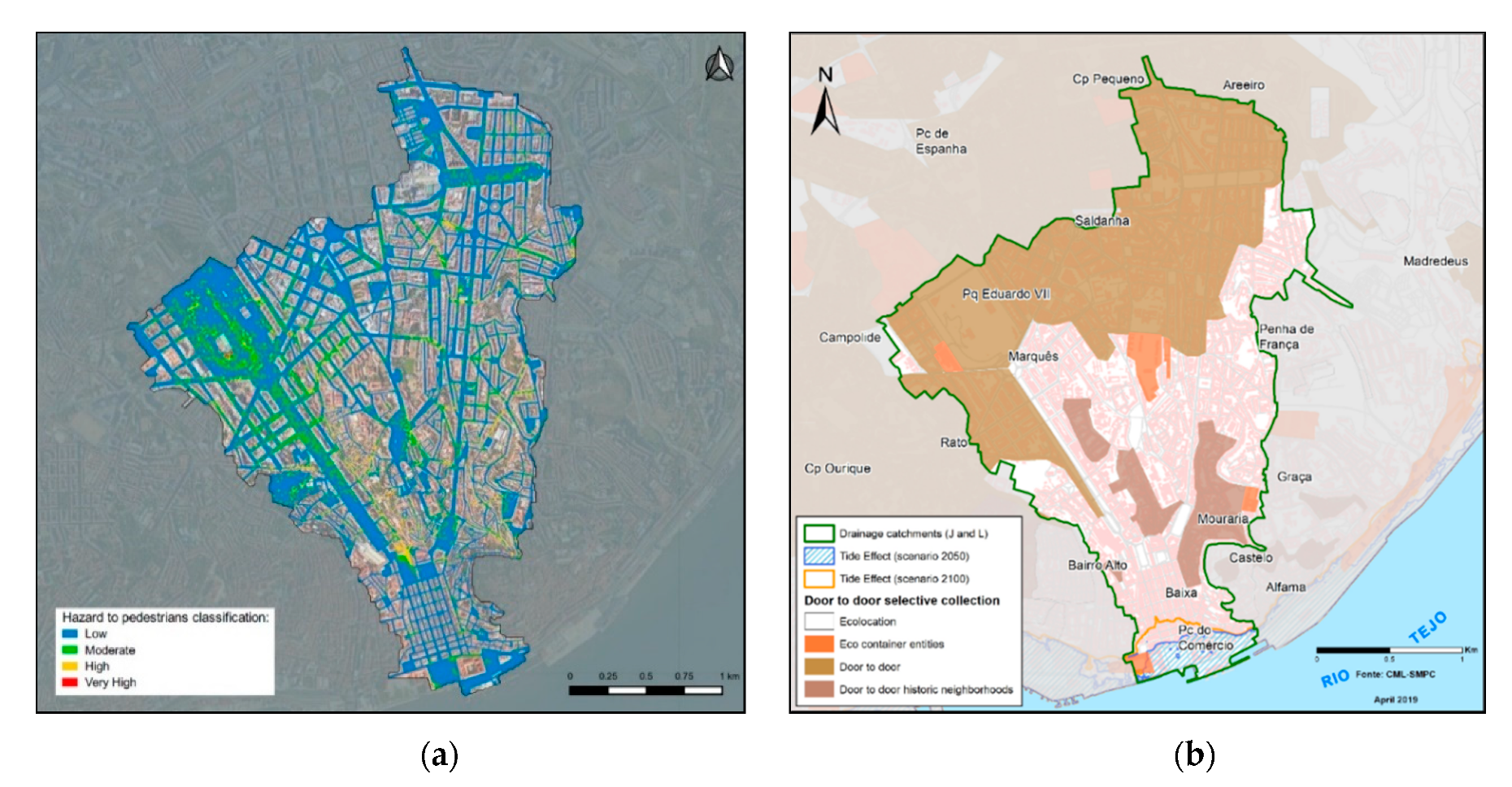
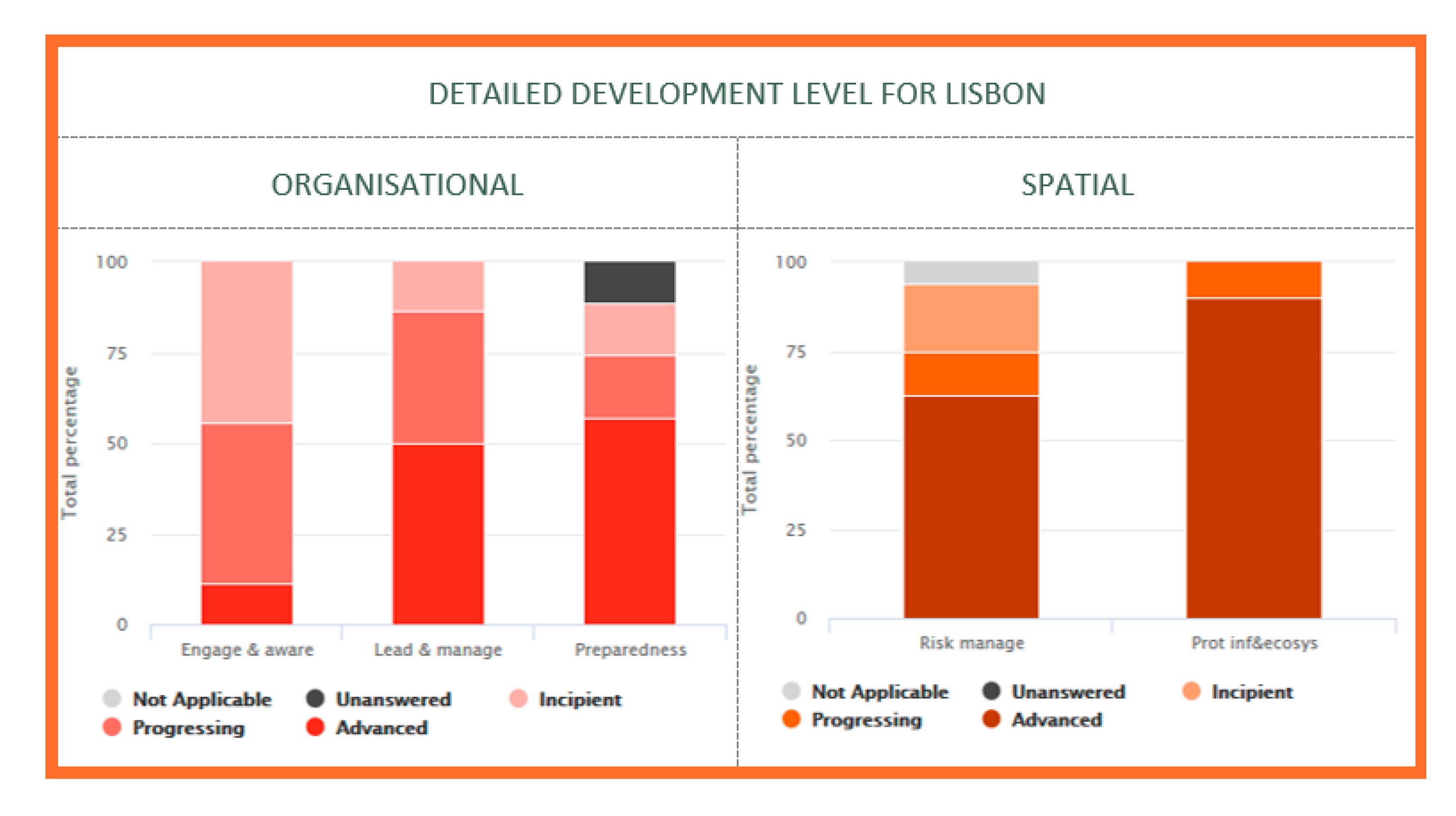

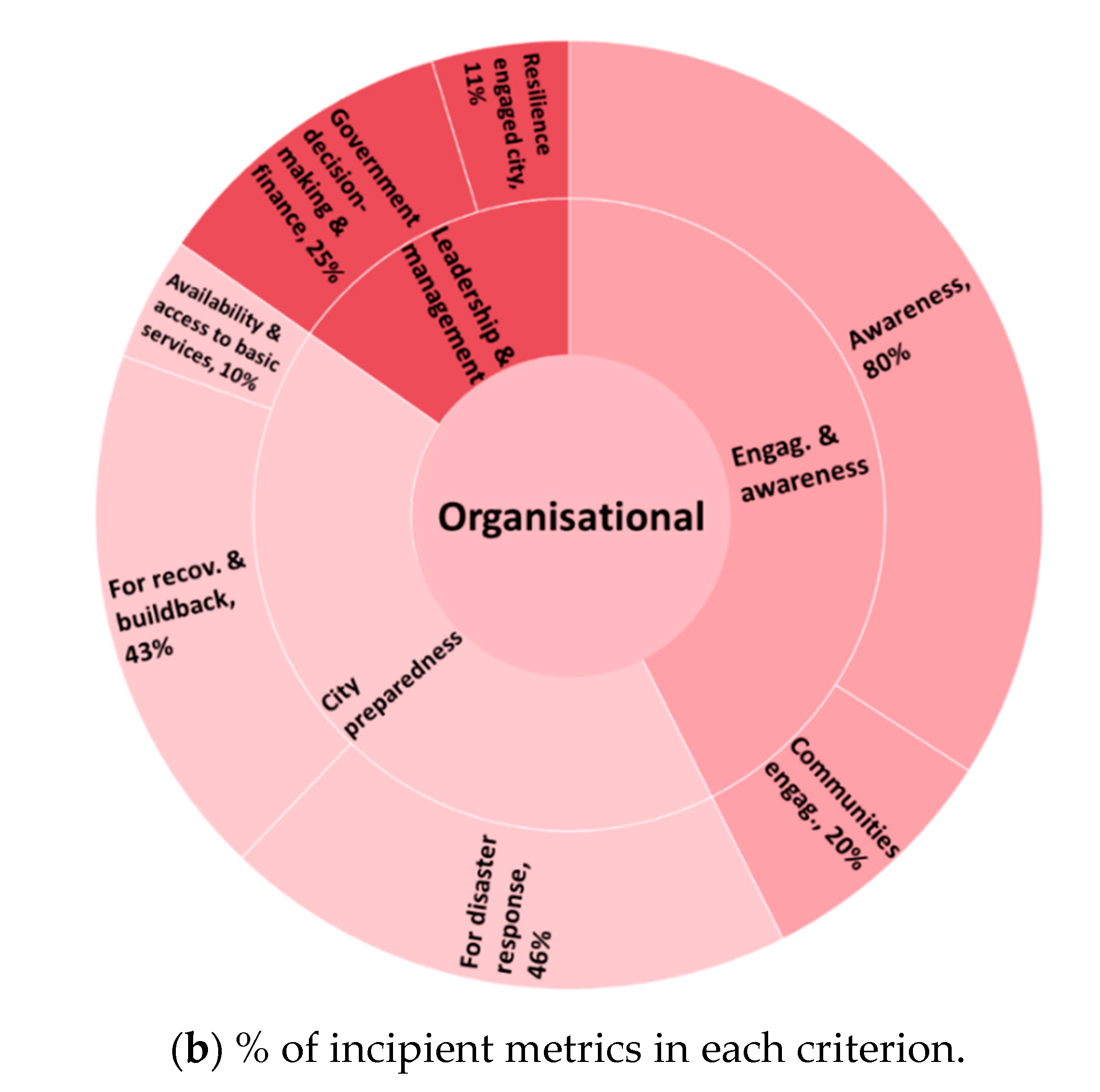

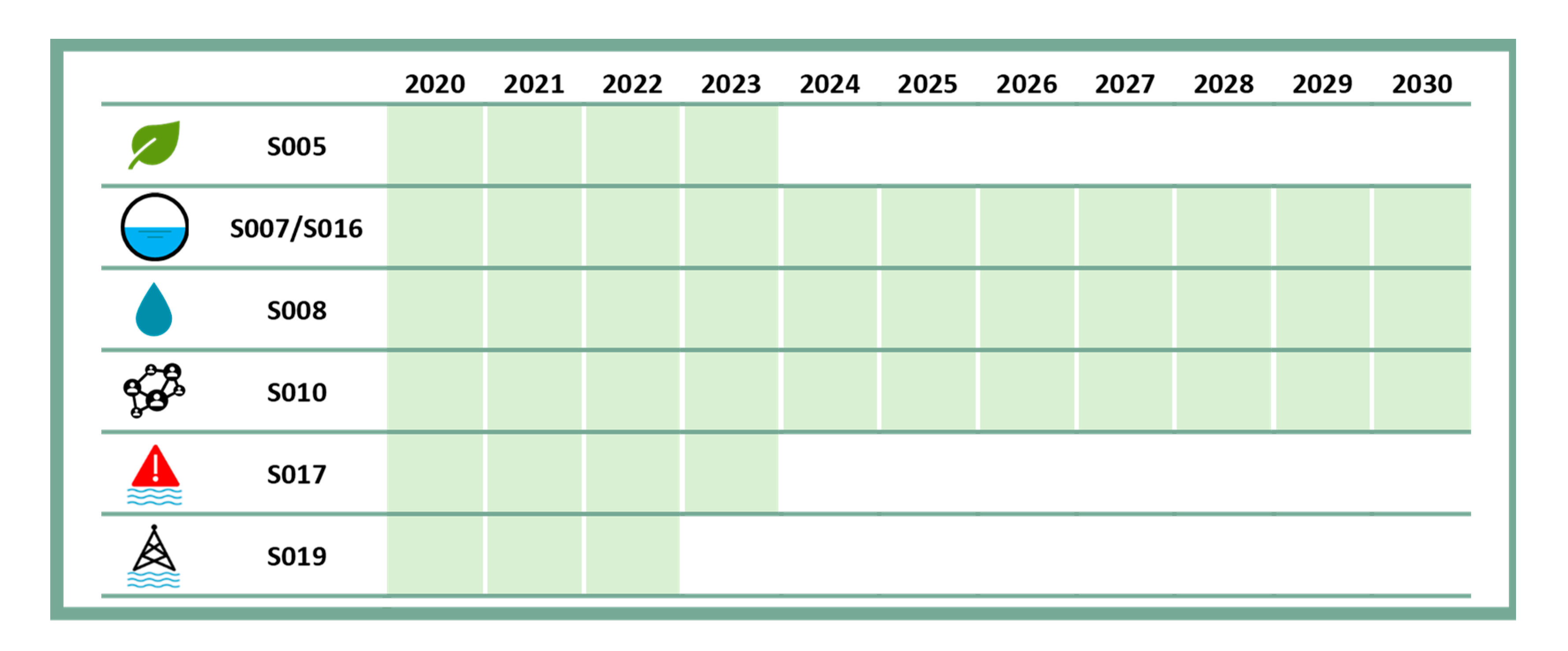
| Barcelona | Bristol | Lisbon | |
|---|---|---|---|
| Location |
|
|
|
| Population |
|
|
|
| Major vulnerabilities |
|
|
|
| Background |
|
|
|
| Vision |
|
|
|
| RAP Geographical scope and planning horizon |
|
|
|
| Barcelona | Bristol | Lisbon | ||
|---|---|---|---|---|
| Most probable planning scenario | Intense precipitation | - 1-year return period - Increase of 9–18% to account for CC RCP4.5 and 8.5 - Period 2071–2100 | - 1–5 years return period - Aggravation of 40% to account for CC RCP 8.5, 10–20 mm - Year 2115 | - 10 years return period - Relative change of 1 h rainfall intensity in +17%, to account for CC - Period 2071–2100 |
| Sea level rise | - Expected mean sea level rise: +20 cm - Increase to account for CC RCP4.5 - Period 2071–2100 | - Tide level = 8.5 mAOD (Metres Above Ordnance Datum) - Aggravation of 1.0 m rise to account for CC RCP 4.5 - Year 2120 | - Tide level = 1.95 m | |
| Most severe planning scenario | Intense precipitation | - 500 years return period - Increase of 7–26% to account for CC RCP4.5 and 8.5 - Period 2071–2100 | - 100 years return period - Aggravation of 40% to account for CC, 200 mm in 3 h RCP 8.5 - Year 2115 | - 100 years return period - Relative change of 1 h rainfall intensity in +19%, to account for CC - Period 2071–2100 |
| Sea level rise | - Expected mean sea level rise: = +30 cm - Increase to account for CC RCP8.5 - Period 2071–2100 | - Tide level = 9.4 mAOD 0.5% AEP (Annual Exceedance Probability) - Aggravation of 1.0 m rise to account for CC RCP 4.5 - Year 2120 | - Tide level = 2.81 m - Year 2100 |
| Strategies (Id) | Resilience Objectives Impacted | |
|---|---|---|
| Barcelona | Reduce the impacts of flooding events | - Provision of Protective Infrastructure and Ecosystems (S2-Spatial); - Functional and Physical dimensions of stormwater service |
| Improve the receiving water bodies | - City preparedness (O3–Organizational) - Physical dimension of wastewater and stormwater services | |
| Use alternative water resources to increase water availability | - Functional and Physical dimensions of water service | |
| Guarantee security of services provision | - All objectives of Organizational dimension - Spatial Risk Management (S1) - Functional and Physical dimensions of all services | |
| Bristol | Develop community flood plans | - Collective Engagement and Awareness (O1–Organizational) - Spatial Risk Management (S1) - Functional dimension of stormwater and energy services of |
| Keep identification of high-risk areas updated by conducting studies involving flood-modelling analysis | - Leadership and Management (O2–Organizational) - Spatial Risk Management (S1) - Functional and Physical dimensions of all services | |
| Build riverside flood defense walls | - Spatial Risk Management (S1); Provision of Protective Infrastructure and Ecosystems (S2-Spatial); - Functional and Physical dimensions of all services | |
| Reduce surface water runoff and sewer overload by adding raingardens before sewer inlets. | - Provision of Protective Infrastructure and Ecosystems (S2-Spatial); - Functional and Physical dimensions of stormwater service | |
| Lisbon | Adaptation of green infrastructure (S005) | - City preparedness (O3–Organizational) - Spatial Risk Management (S1); Provision of Protective Infrastructure and Ecosystems (S2-Spatial) - Functional and Physical dimensions of stormwater service - Physical dimension of wastewater service |
| Promoting urban rehabilitation as a tool to increase resilience: sewer systems (S007) | - Leadership and Management (O2–Organizational); City preparedness (O3–Organizational) - Spatial Risk Management (S1); Provision of Protective Infrastructure and Ecosystems (S2-Spatial) - Functional and Physical dimensions of all services | |
| Promoting urban rehabilitation as a tool to increase resilience: facing climate change (S008) | ||
| Construction of new components in drainage system (S016) | ||
| Strengthening collaboration within AML, Parishes and municipality departments (S010) | - All objectives of Organizational dimension (O1, O2, O3) - Spatial Risk Management (S1) - Functional and Physical dimensions of all services | |
| Lisbon urban drainage monitoring and early-warning system (S017) | - Leadership and Management (O2–Organizational); City preparedness (O3–Organizational) - Spatial Risk Management (S1) - Functional dimension of all services | |
| Building protections for urban electrical infrastructure, exposed to estuarine flood (S019) | - City preparedness (O3–Organizational) - Spatial Risk Management (S1); Provision of Protective Infrastructure and Ecosystems (S2-Spatial) - Functional and Physical dimensions of all services |
| Barcelona | Bristol | Lisbon | ||||
|---|---|---|---|---|---|---|
| Monitoring | Review | Monitoring | Review | Monitoring | Review | |
| Periodicity | 2 years | 10 years | Yearly | Yearly | 2 years | 10 years |
| Responsible body | Barcelona City Council | Bristol City Council | Lisbon Municipality | |||
| Activities | Monitoring:
| |||||
| - Evaluate monitoring process | ||||||
Publisher’s Note: MDPI stays neutral with regard to jurisdictional claims in published maps and institutional affiliations. |
© 2020 by the authors. Licensee MDPI, Basel, Switzerland. This article is an open access article distributed under the terms and conditions of the Creative Commons Attribution (CC BY) license (http://creativecommons.org/licenses/by/4.0/).
Share and Cite
Cardoso, M.A.; Telhado, M.J.; Almeida, M.d.C.; Brito, R.S.; Pereira, C.; Barreiro, J.; Morais, M. Following a Step by Step Development of a Resilience Action Plan. Sustainability 2020, 12, 9017. https://doi.org/10.3390/su12219017
Cardoso MA, Telhado MJ, Almeida MdC, Brito RS, Pereira C, Barreiro J, Morais M. Following a Step by Step Development of a Resilience Action Plan. Sustainability. 2020; 12(21):9017. https://doi.org/10.3390/su12219017
Chicago/Turabian StyleCardoso, Maria Adriana, Maria João Telhado, Maria do Céu Almeida, Rita Salgado Brito, Cristina Pereira, João Barreiro, and Marco Morais. 2020. "Following a Step by Step Development of a Resilience Action Plan" Sustainability 12, no. 21: 9017. https://doi.org/10.3390/su12219017
APA StyleCardoso, M. A., Telhado, M. J., Almeida, M. d. C., Brito, R. S., Pereira, C., Barreiro, J., & Morais, M. (2020). Following a Step by Step Development of a Resilience Action Plan. Sustainability, 12(21), 9017. https://doi.org/10.3390/su12219017







